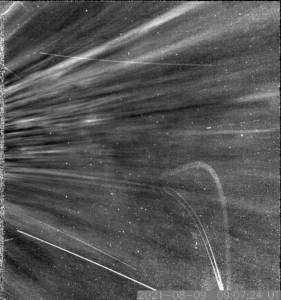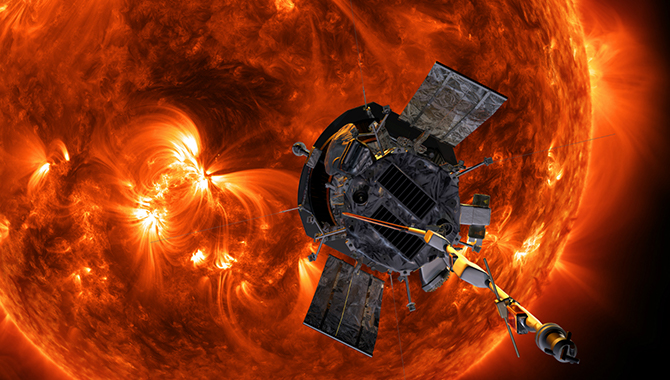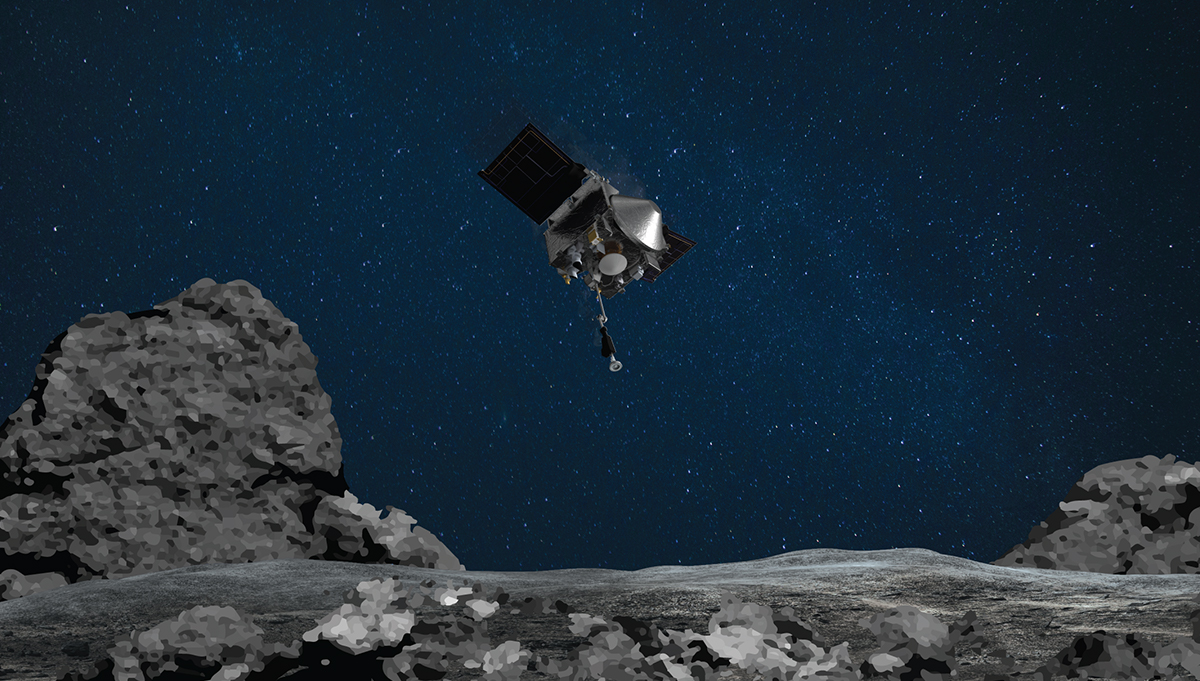
NASA’s Perseverance Rover surveys the floor of Jezero Crater on Feb. 5, the 698th Martian day, or sol, of the mission. The rover began its third year on Mars recently.
Credit: NASA/JPL-Caltech
A unique view of the Sun, gathering Martian dust, and preparing for asteroid samples.

As Parker Solar Probe passed through the corona on encounter nine, the spacecraft flew by structures called coronal streamers. These structures can be seen as bright features moving upward in the upper images and angled downward in the lower row. Such a view is only possible because the spacecraft flew above and below the streamers inside the corona. Until now, streamers have only been seen from afar. They are visible from Earth during total solar eclipses.
Credit: NASA/Johns Hopkins APL/Naval Research Laboratory
Parker Solar Probe gets closer to the Sun as solar activity accelerates.
On March 17, the Parker Solar Probe reached the perihelion of its 15th orbit around the Sun, traveling in excess of 364,000 miles per hour through the corona’s intense heat. The probe was just 5.3 million miles from the Sun’s surface at the closest point and was visible to observatories on Earth and elsewhere in space during the orbit, giving the team the opportunity to monitor solar events from multiple distances.
“When we can observe the same solar phenomena as they travel from the Sun out into the solar system, we have a notable opportunity to see how structures like the solar wind change as they move through time and space,” said Nour Raouafi, Parker’s project scientist at the Johns Hopkins Applied Physics Laboratory in Laurel, Maryland, in a blog post.
The 15th orbit was considerably faster and closer than the first, in 2018, when the spacecraft reached 213,200 miles per hour while coming within 15 million miles of the Sun’s surface. During the last of 24 planned orbits, it is expected to reach a peak speed of 430,000 miles per hour, making it the fastest humanmade object ever. At its nearest point, the spacecraft will be within 3.83 million miles of the Sun’s surface.
As the probe orbits closer, activity is increasing in Solar Cycle 25. Predicted to be more active than recent cycles, but weaker than average, the cycle has so far exceeded expectations. March featured a sunspot the size of Earth, multiple solar flares, and geomagnetic storms as the cycle builds to a peak in about two years.
Teams prepare for OSIRIS-REx sample.
NASA’s OSIRIS-REx spacecraft will arrive at Earth later this year, capping a 4.4-billion-mile round trip to Bennu, an asteroid that scientist believe is an artifact from the early solar system. Within OSIRIS-REx is a capsule that contains about eight ounces of pristine regolith from the asteroid. On September 24, the capsule will streak into Earth’s atmosphere traveling 27,700 miles per hour. Deploying parachutes, it will come to rest 13 minutes later in the desert of southwest Utah, on land within either the Utah Test and Training Range or the adjacent Dugway Proving Grounds.
Teams will prepare through the summer to locate the sample in a target area that is 37-miles long by 9-miles wide and secure it in a temporary clean room before ultimately transferring it to NASA’s Johnson Space Center in Houston. Construction was completed in 2021 on new curation facility there to store samples from OSIRIS-REx and the Japan Aerospace Exploration Agency’s Hayabusa2 mission. The facility includes new storage areas, cleaning facilities, research labs, and tools to study the regolith down to the molecular level without destroying it. NASA’s Astromaterials Research and Exploration Science division will curate the samples.
The asteroid regolith is highly prized by researchers because, unlike asteroid fragments that fall to Earth, the OSIRIS-REx sample will be unaltered by the scorching journey through Earth’s atmosphere or by weather or soil contamination. The sample could hold clues to important questions about the early solar system, the role of prebiotic molecules in the origins of life, and how volatiles or organic compounds are delivered throughout the solar system.

A tray holding 39 sample tubes – each protected in a gold-colored sheath – is installed in NASA’s Perseverance rover in this picture taken at the agency’s Kennedy Space Center on May 21, 2020.
Credits: NASA/JPL-Caltech/KSC
Perseverance on Jezero’s fan delta.
NASA’s Perseverance Rover began its third year on Mars in February, having traversed nearly 10 miles, collecting samples from one of the most promising sites in which to search for evidence of past life on Mars—Jezero Crater. The crater, about 30 miles in diameter, is marked by a fan-delta, deposits of clays and carbonates, and other features that signal the site was likely a lake in the planet’s distant past—more than 3.5 billion years ago.
The rover is atop curved rock layers that appear from overhead images to be layers of riverbed deposited over a delta, complete with boulders pulled in from distant areas by flowing water. The team plans to spend time there, studying the formation.
Perseverance has collected 18 samples so far, filling and sealing close to half of the 38 titanium tubes dedicated to samples aboard the rover. The rover collected its first two samples of Martian regolith in early December 2022. Understanding dust and regolith on Mars will be crucial to a future human mission to the planet. Some dust grains could be exceptionally fine and sharp, causing damage to an astronaut’s spacesuit, breathing apparatus, and habitat, as well as to tools and robotic missions. NASA’s InSight Lander was retired in December after a buildup of Martian dust reduced its ability to generate power.









